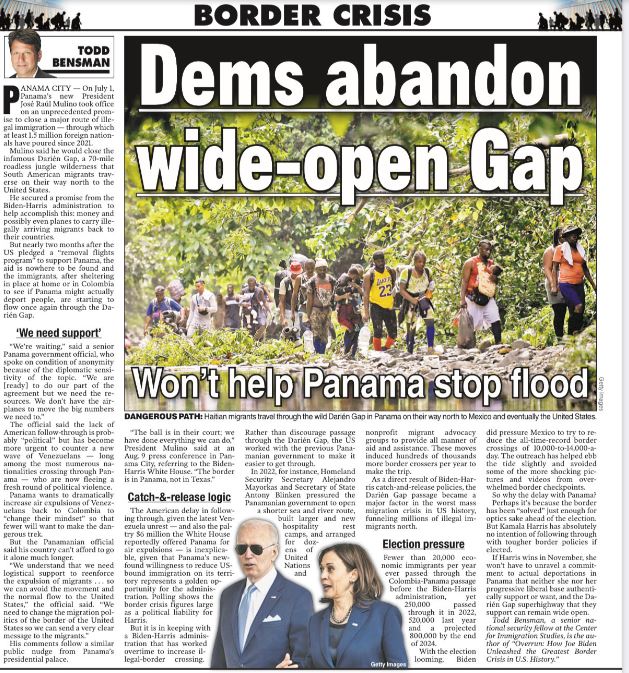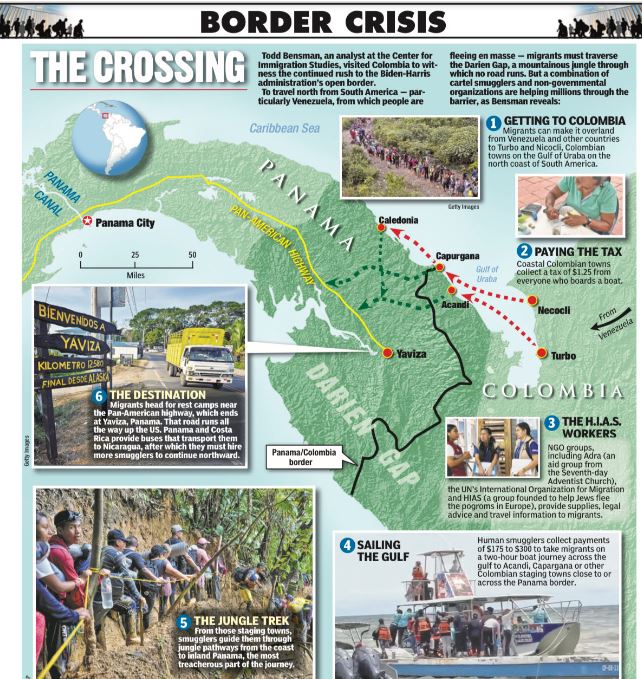
By Todd Bensman as published August 15, 2024 by The New York Post
PANAMA CITY — On July 1, Panama’s new President José Raúl Mulino took office on an unprecedented promise to close a major route of illegal immigration — through which at least 1.5 million foreign nationals have poured through since 2021.
Mulino said he would close the infamous Darién Gap, a 70-mile roadless jungle wilderness that South American migrants traverse on their way north to the United States.
SEE ALL BENSMAN’S DARIEN GAP VIDEO, PHOTOS AND PUBLISHED REPORTS HERE
He secured a promise from the Biden-Harris administration to help accomplish this: money and possibly even planes to carry illegally arriving migrants back to their countries.
But nearly two months after the US pledged a “removal flights program” to support Panama, the aid is nowhere to be found and the immigrants, after sheltering in place at home or in Colombia to see if Panama might actually deport people, are starting to flow once again through the Darién Gap.
‘We need support’

“We’re waiting,” said a senior Panama government official, who spoke on condition of anonymity because of the diplomatic sensitivity of the topic. “We are [ready] to do our part of the agreement but we need the resources. We don’t have the airplanes to move the big numbers we need to.”
The official said the lack of American follow-through is probably “political” but has become more urgent to counter a new wave of Venezuelans — long among the most numerous nationalities crossing through Panama — who are now fleeing a fresh round of political violence.
Panama wants to dramatically increase air expulsions of Venezuelans back to Colombia to “change their mindset” so that fewer will want to make the dangerous trek.
But the Panamanian official said his country can’t afford to go it alone much longer.
“We understand that we need logistical support to reenforce the expulsion of migrants . . . so we can avoid the movement and the normal flow to the United States,” the official said. “We need to change the migration politics of the border of the United States so we can send a very clear message to the migrants.”
His comments follow a similar public nudge from Panama’s presidential palace.
“The ball is in their court; we have done everything we can do,” President Mulino said at an Aug. 9 press conference in Panama City, referring to the Biden-Harris White House. “The border is in Panama, not in Texas.”



Catch-&-release logic
The American delay in following through, given the latest Venezuela unrest — and also the paltry $6 million the White House reportedly offered Panama for air expulsions — is inexplicable, given that Panama’s newfound willingness to reduce US-bound immigration on its territory represents a golden opportunity for the administration.
Polling shows the border crisis figures large as a political liability for Harris.
But it is in keeping with a Biden-Harris administration that has worked overtime to increase illegal-border crossing.
Rather than discourage passage through the Darién Gap, the US worked with the previous Panamanian government to make it easier to get through.
In 2022, for instance, Homeland Security Secretary Alejandro Mayorkas and Secretary of State Antony Blinken pressured the Panamanian government to open a shorter sea and river route, built larger and new hospitality rest camps, and arranged for dozens of United Nations and nonprofit migrant advocacy groups to provide all manner of aid and assistance.
These moves induced hundreds of thousands more border crossers per year to make the trip.
As a direct result of Biden-Harris catch-and-release policies, the Darién Gap passage became a major factor in the worst mass migration crisis in US history, funneling millions of illegal immigrants north.
Election pressure
Fewer than 20,000 economic immigrants per year ever passed through the Colombia-Panama passage before the Biden-Harris administration, yet 250,000 passed through it in 2022, 520,000 last year and a projected 800,000 by the end of 2024.
With the election looming, Biden did pressure Mexico to try to reduce the all-time-record border crossings of 10,000-to-14,000-a-day.
The outreach has helped ebb the tide slightly and avoided some of the more shocking pictures and videos from overwhelmed border checkpoints.
So why the delay with Panama?
Perhaps it’s because the border has been “solved” just enough for optics sake ahead of the election. But Kamala Harris has absolutely no intention of following through with tougher border policies if elected.
If Harris wins in November, she won’t have to unravel a commitment to actual deportations in Panama that neither she nor her progressive liberal base authentically support or want, and the Darién Gap superhighway that they support can remain wide open.